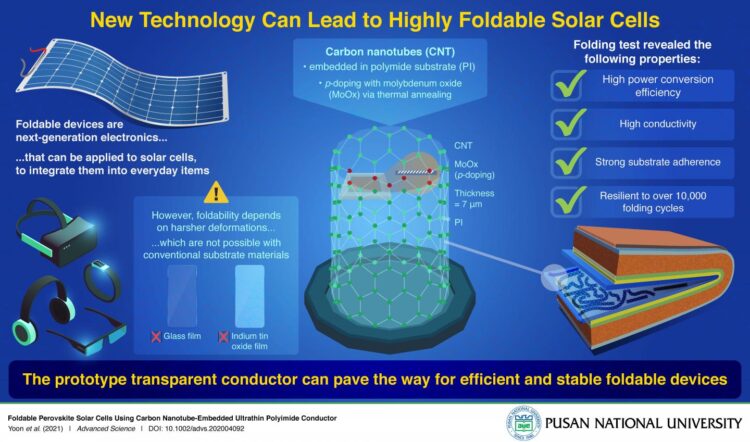International research team creates solar cells with unprecedented flexibility and resistance

Credit: Pusan National University
With the recent development of foldable mobile phone screens, research on foldable electronics has never been so intensive. One particularly useful application of the foldable technology is in solar panels.
Current solar cells are restricted to rigid, flat panels, which are difficult to store in large numbers and integrate into everyday appliances, including phones, windows, vehicles, or indoor devices. But, one problem prevents this formidable technology from breaking through: to be integrated into these items, solar cells need to be foldable, to bend at will repeatedly without breaking. Traditional conducting materials used in solar cells lack flexibility, creating a huge obstacle in developing fully foldable cells.
A key requirement for an efficient foldable conductor is the ability to withstand the pressure of bending within a very small radius while maintaining its integrity and other desirable properties. In short, a thin, flexible, transparent, and resilient conductor material is needed. Professor Il Jeon of Pusan National University, Korea, elaborates, “Unlike merely flexible electronics, foldable devices are subject to much harsher deformations, with folding radii as small as 0.5 mm. This is not possible with conventional ultra-thin glass substrates and metal oxide transparent conductors, which can be made flexible but never fully foldable.”
Fortunately, an international team of researchers, including Prof. Jeon, have found a solution, in a study published in Advanced Science. They identified a promising candidate to answer all of these requirements: single-walled carbon nanotube (SWNT) films, owing to their high transparency and mechanical resilience. The only problem is that SWNTs struggle to adhere to the substrate surface when force is applied (such as bending) and requires chemical doping. To address this problem, the scientists embedded the conducting layer into a polyimide (PI) substrate, filling the void spaces in the nanotubes.
To ensure maximum performance, they also “doped” the resulting material to increase its conductivity. By introducing small impurities (in this case, withdrawn electrons to molybdenum oxide) into the SWNT-PI nanocomposite layer, the energy needed for electrons to move across the structure is much smaller, and hence more charge can be generated for a given amount of current.
Their resulting prototype far exceeded the team’s expectations. Only 7 micrometers thick, the composite film exhibited exceptional resistance to bending, almost 80% transparency, and a power conversion efficiency of 15.2%, the most ever achieved in solar cells using carbon nanotube conductors! In fact, as pointed out by Prof. Jeon, “The obtained results are some of the best among those reported thus far for flexible solar cells, both in terms efficiency and mechanical stability.”
With this novel breakthrough in solar harvesting technology, one can only imagine what next-generation solar panels will look like.
###
Reference
Title of original paper: Foldable Perovskite Solar Cells Using Carbon Nanotube-Embedded Ultrathin Polyimide Conductor
Journal: Advanced Science
DOI: https:/
About Pusan National University
Pusan National University, located in Busan, South Korea, was founded in 1946, and is now the no. 1 national university of South Korea in research and educational competency. The multi-campus university also has other smaller campuses in Yangsan, Miryang, and Ami. The university prides itself on the principles of truth, freedom, and service, and has approximately 30,000 students, 1200 professors, and 750 faculty members. The university is composed of 14 colleges (schools) and one independent division, with 103 departments in all.
Website: https:/
About Jeon Lab
Website: https:/
About the authors
Prof. Il Jeon is a Professor of Chemistry Education and Chemical Materials at Pusan National University, Korea. He completed his undergraduate degree at Oxford University, UK, and received a Ph.D. in Chemistry with honors from the University of Tokyo, Japan. Following this, he worked at LG Display Co. Ltd., South Korea, as a Senior Research engineer and then started a postdoctoral fellowship at the University of Tokyo. After completing his fellowship, he worked as an assistant professor and lecturer at the same university. His research group at Pusan National University is working on nanocarbon materials, namely, endohedral fullerene, and carbon nanotubes, for optoelectronics and energy device applications. The team is also developing bioelectronics and integration of artificial intelligence with material science.
Dr. Jungjin Yoon is a postdoctoral researcher at the Pennsylvania State University (PSU), US. He obtained his Bachelor’s and Ph.D. degrees in mechanical engineering at Kyung Hee University and Seoul National University, Korea, respectively. Before joining PSU, he worked at the Korea Institute of Science and Technology, Korea, as a postdoctoral researcher. With his research experience in mechanical engineering and material science, his research interest now is the perovskite-based flexible optoelectronic devices, the development of transparent conductors, and the device fabrication/integration process.
Media Contact
Young-suk Hwang
[email protected]
Original Source
http://www.
Related Journal Article
http://dx.





